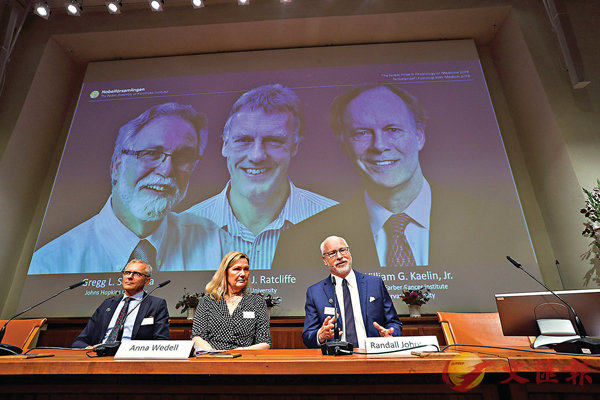 ■今年醫學獎由3名科學家共同奪得。 資料圖片
■今年醫學獎由3名科學家共同奪得。 資料圖片【原文】任何動物均需借助氧(oxygen)把食物轉化為能量,當身體含氧量改變,體內細胞(cell)便需作出相應調整,繼續有效提供能量。3名分別來自美國和英國的科學家塞門薩(Gregg L. Semenza)、雷克利夫(Sir Peter J. Ratcliffe)和凱林(William G. Kaelin Jr.)憑研究細胞缺氧(hypoxia)反應的機制,揭開氧氣對細胞活動的具體影響,成為治療癌症、貧血(anemia)等多種疾病的新希望,共同奪得今年度諾貝爾醫學獎(Nobel Prize in Physiology or Medicine)。
動物細胞和組織可攝取的氧含量時有變化,例如高地(highland)環境氧含量較少,當人體缺氧時,紅血球生成素(erythropoietin)(EPO)含量會增加,讓身體製造更多紅血球(red blood cell),亦可能製造新血管(blood vessel),即使早於胚胎初形成(embryonic development)時,人體已有適應含氧量變化的能力。然而科學家一直無法解答,氧分子在這過程扮演的角色。
美國約翰霍普金斯大學(Johns Hopkins University)教授塞門薩和英國牛津大學(University of Oxford)教授雷克利夫,多年來研究含氧量與EPO的關係,其中塞門薩運用基因改造(gene-modified)老鼠,發現人類所有組織均能感應含氧量的變化,而非限於產生EPO的腎臟(kidney),而EPO的活躍程度,則受缺氧反應元(hypoxia-response element)(HRE)的脫氧核糖核酸(deoxyribonucleic acid)(DNA)中一組蛋白(protein)影響,名為缺氧誘導因子(hypoxia-inducible factor)(HIF)。
塞門薩於1995年進一步確認,HIF由兩組蛋白組成,分別為HIF-1α和ARNT(又稱HIF-1β)。塞門薩及雷克利夫發現當含氧量偏高時,細胞只含有少量HIF-1α,原因是它會跟人體中的氧產生降解反應(degradation),最終消失。當含氧量下降,HIF-1α則會跟ARNT結合,使EPO含量上升,但科學家仍未得悉當中機制。
美國哈佛大學(Harvard University)教授凱林在研究罕見遺傳疾病「VHL症候群」(Von Hippel-Lindau's disease)時,發現當癌細胞缺乏VHL基因,細胞內的HIF-1α含量將非常高,而向癌細胞注入VHL基因後,細胞便恢復正常,顯示VHL基因或會影響細胞是否出現缺氧反應。雷克利夫其後再進行實驗,證實VHL基因正是HIF-1α降解反應的關鍵。
雷克利夫和凱林隨後繼續探究氧分子、VHL與HIF-1α之間的互動,並於2001年同時(simultaneously)發表研究結果。兩人發現當氧含量正常時,氧分子會變成氫氧根(hydroxyl groups),並與HIF-1α結合。VHL這時會識別出HIF-1α,製造降解反應,HIF-1α因此消失,無法促使EPO活動。而在缺氧情況下,由於氧分子減少,因此無法吸引VHL,使HIF-1α得以跟ARNT結合,成為HIF,進而刺激EPO活動,製造更多紅血球。
大部分疾病的其中一個根源(root cause),正是細胞無法回應含氧量變化,例如癌細胞會干擾人體製造新血管的過程,使癌細胞更易繁殖(proliferation)。醫藥界基於塞門薩等人的研究結果,研發刺激或阻止細胞缺氧反應的藥物,例如只要讓人體製造更多紅血球,便可望治癒貧血。
評審形容3人確立氧氣含量對細胞新陳代謝(metabolism),以及其他生理活動的影響,大幅擴闊人們對生物反應的認知,有助革新對抗疾病的策略(strategy),他們將平均瓜分900萬瑞典克朗(約720萬港元)獎金。
2019 Nobel Prize in Medicine jointly awarded to three scientists for new treatments for cancer and anemia
【譯文】All animals need oxygen for the conversion of food into useful energy, and whenever the levels of oxygen in the animal bodies change, the cells will adjust themselves to adapt to the changes so as to maintain energy supply. Three scientists from America and Britain, namely Gregg L. Semenza, Sir Peter J. Ratcliffe and William G. Kaelin Jr., were jointly awarded the 2019 Nobel Prize in Physiology or Medicine for their discoveries on the mechanism of how cells respond to oxygen availability and hypoxia, revealing substantially the impact of oxygen on animal cells and paving the way for fighting against cancer, anemia and many other diseases.
The levels of oxygen in animal cells and tissues vary from time to time, for example, people might face low oxygen levels on highlands, by then the levels of the hormone erythropoietin (EPO) will rise, contributing to an increased production of red blood cells or new blood vessels, and it is found that human beings are adaptable to varying levels of oxygen even before embryonic development. Yet, how this process is itself controlled by O2 remains a mystery to scientists.
Gregg L. Semenza, professor of the U.S. Johns Hopkins University, together with Sir Peter J. Ratcliffe, professor of the U.K. University of Oxford, have long been studying the relationship between the EPO gene and varying oxygen levels. By using gene-modified mice, Semenza discovered that the oxygen sensing mechanism is present in all human tissues, but not merely confined to the kidney cells where EPO is normally produced. It was also discovered that the activity of EPO is associated with a DNA-binding protein complex in the hypoxia-response element (HRE), which is encoded as hypoxia-inducible factor (HIF).
In 1995, Semenza further discovered that HIF was found to consist of two different DNA-binding proteins, namely HIF-1α and ARNT (also called HIF-1β). When oxygen levels are high, cells contain very little HIF-1α. This is because it will normally react with oxygen and be rapidly degraded. However, when oxygen levels are low, HIF-1α will combine with ARNT to increase the amount of EPO gene, but such oxygen-dependent mechanism is yet to be revealed by scientists.
On the other hand, during his research study on Von Hippel-Lindau's disease, William G. Kaelin Jr., professor of the U.S. Harvard University, discovered that cancer cells lacking a functional VHL gene express abnormally high levels of HIF-1α, but if VHL gene is reintroduced into cancer cells, normal levels are restored, showing that VHL is an important factor in controlling responses to hypoxia. Several rounds of experiments eventually proved that VHL gene is a key component for HIF-1α degradation.
Ratcliffe and Kaelin continued to study how O2 levels affect the interaction between VHL and HIF-1α, and published their key findings in 2001 simultaneously.
They discovered that under normal oxygen levels, hydroxyl groups are added in HIF-1α, allowing VHL to recognize HIF-1α and regulate its degradation process, and eventually deactivating EPO. But when hypoxia exits, the amount of O2 reduces and so VHL cannot be attracted, making HIF-1α associate with ARNT to become HIF, thereby stimulating EPO activity and producing more red blood cells.
One of the root causes of most diseases is related to the failure of the oxygen sensing mechanism of cells, for example, cancer cells will interfere with the process of producing new blood vessels in the human body, leading to effective proliferation of cancer cells. Based on the scientists' findings, the medical industry is now making intense ongoing efforts to develop drugs either activating or blocking the oxygen-sensing machinery, for instance, by controlling the formation of red blood cells in hope of treating anemia successfully.
The Nobel Committee said the three scientists established the basis for people's understanding of how oxygen levels affect cellular metabolism and physiological function, significantly advancing people's knowledge in biological responses and reforming strategies to fight diseases. The Nobel prize sum of $9 million Swedish kronor (approximately HK$7.2 million) is to be shared equally among them.■龐嘉儀
Q&A
1. 諾貝爾獎項於1895年由誰創立?
2. 承上題,創立者依靠什麼累積了巨大財富?
3. 諾貝爾獎6個獎項中,哪個獎項並非原創?
4. 首位獲得諾貝爾獎的女性是誰?
5. 哪個國際組織獲獎次數最多?
Answer
1. 瑞典發明家諾貝爾(Alfred Nobel)
2. 製造炸藥
3. 經濟學獎
4. 居里夫人
5. 紅十字國際委員會

